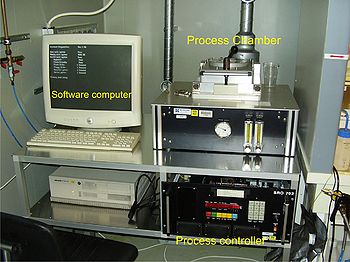Specific Process Knowledge/Thermal Process/BCB Curing Oven: Difference between revisions
mNo edit summary |
No edit summary |
||
| Line 16: | Line 16: | ||
Here are some of the standard processes used in the BCB Curing Oven. | Here are some of the standard processes used in the BCB Curing Oven. | ||
=BCB curing:= | === BCB curing:=== | ||
* Long curing at 210°C: BCB210AL.PDF/[[file:BCB210BL.PDF|BCB210BL.PDF]] | |||
* Long curing at 250°C: BCB250AL.PDF/[[file:BCB250BL.PDF|BCB250BL.PDF]] | |||
The AL/BL processes are (should be) identical except for a (2x) pump/purge cycle in the beginning of the BL processes. | The AL/BL processes are (should be) identical except for a (2x) pump/purge cycle in the beginning of the BL processes. | ||
===General processes=== | |||
=General processes= | |||
There are a number of general processes named DxxxCyyy.PDF. | There are a number of general processes named DxxxCyyy.PDF. | ||
| Line 29: | Line 29: | ||
The Dxxx is the set temperature (in °C) and the Cyyy is the time (in minutes) at the set temperature. | The Dxxx is the set temperature (in °C) and the Cyyy is the time (in minutes) at the set temperature. | ||
The oven heats to the set temperature (xxx) in 5 mins and then stays at the temperature (xxx) for a time (yyy) after which it cools to | The oven heats to the set temperature (xxx) in 5 mins and then stays at the temperature (xxx) for a time (yyy) after which it cools to room temperature as fast as possible. | ||
The program sequence looks like this for the file D200C060.PDF: | The program sequence looks like this for the file D200C060.PDF: | ||
<pre>; | |||
< | |||
; | |||
; stored 31.08.2011 at 18:15:47 | ; stored 31.08.2011 at 18:15:47 | ||
{P0} | {P0} | ||
| Line 41: | Line 39: | ||
02,05:00,0002,- C 1 - - - - - - | 02,05:00,0002,- C 1 - - - - - - | ||
03,00:00,0000,- C - - - - - - - | 03,00:00,0000,- C - - - - - - - | ||
</ | </pre> | ||
==Equipment performance and process related parameters== | ==Equipment performance and process related parameters== | ||
Revision as of 14:57, 25 March 2013
BCB Curing Oven
The BCB Curing Oven is mainly used for curing of BCB (bisbenzocyclobutene) and for alloying of metals in a nitrogen atmosphere.
During processing the furnace is rapidly heated by use of eight halogen lamps situated below the sample. The furnace is purged with a high or a low nitrogen flow. Samples are processed at atmospheric pressure or at vacuum.
The user manual, user APV, technical information and contact information can be found in LabManager:

Process information
Here are some of the standard processes used in the BCB Curing Oven.
BCB curing:
- Long curing at 210°C: BCB210AL.PDF/File:BCB210BL.PDF
- Long curing at 250°C: BCB250AL.PDF/File:BCB250BL.PDF
The AL/BL processes are (should be) identical except for a (2x) pump/purge cycle in the beginning of the BL processes.
General processes
There are a number of general processes named DxxxCyyy.PDF.
The Dxxx is the set temperature (in °C) and the Cyyy is the time (in minutes) at the set temperature.
The oven heats to the set temperature (xxx) in 5 mins and then stays at the temperature (xxx) for a time (yyy) after which it cools to room temperature as fast as possible.
The program sequence looks like this for the file D200C060.PDF:
;
; stored 31.08.2011 at 18:15:47
{P0}
00,05:00,0200,H - - 2 - - - - -,075,250,001,005,028
01,60:00,0200,H C 1 - - - - - -
02,05:00,0002,- C 1 - - - - - -
03,00:00,0000,- C - - - - - - -
| Equipment | BCB Curing Oven | |
|---|---|---|
| Purpose |
| |
| Process parameter range | Temperature |
|
| Nitrogen flows |
| |
| Pressure |
| |
| Substrates
(Remember to use the right carrier wafer) |
Batch size |
|
| Allowed materials |
| |
